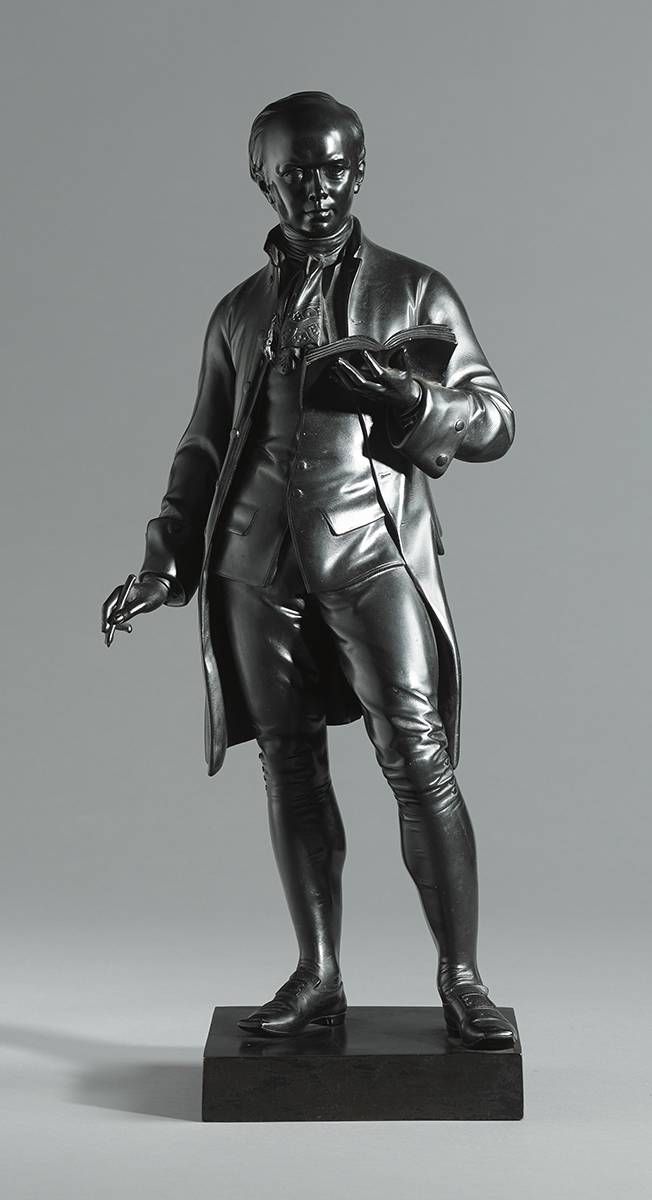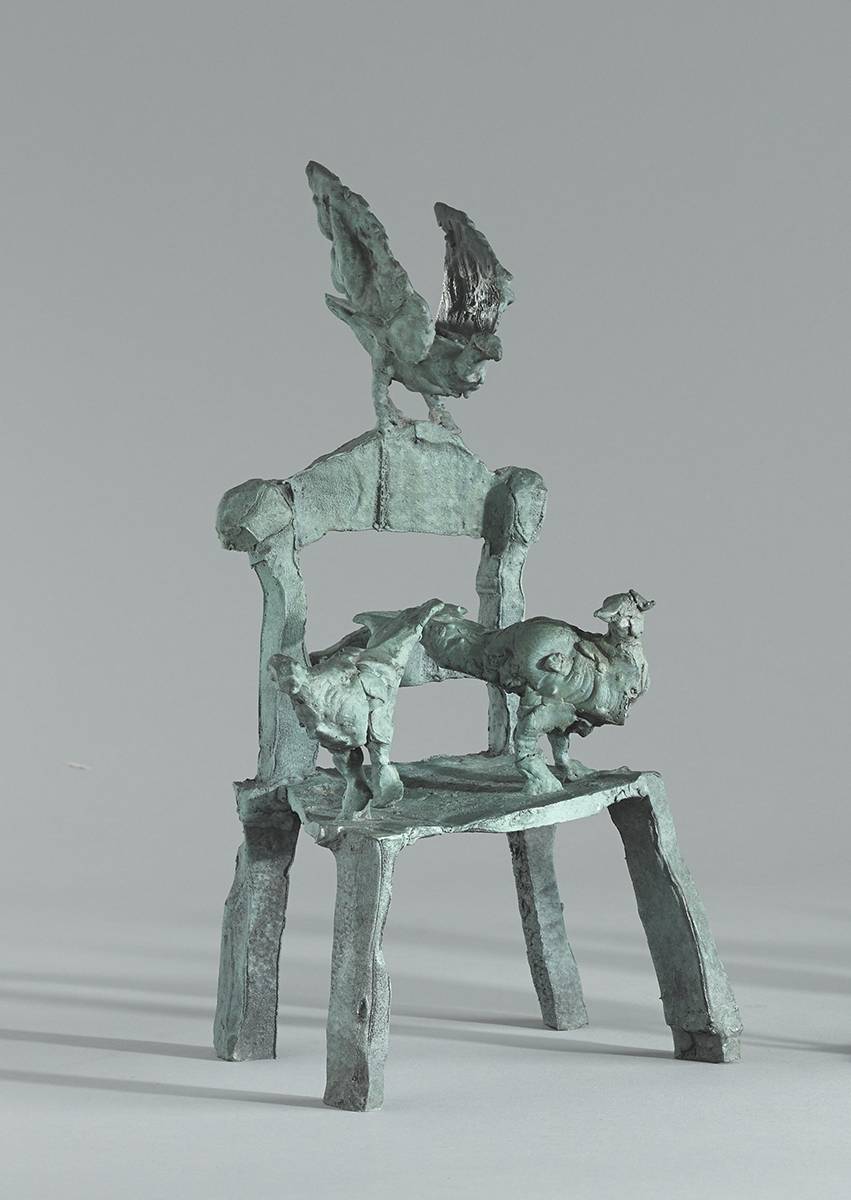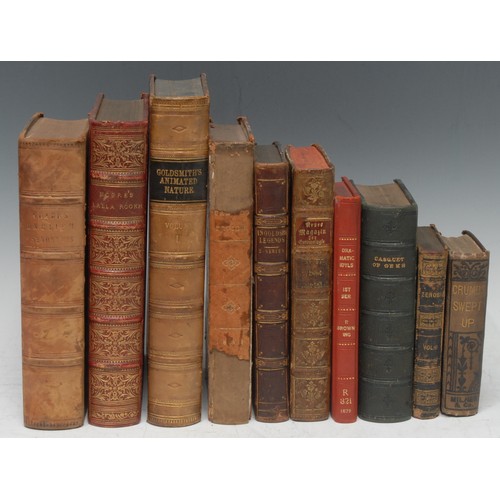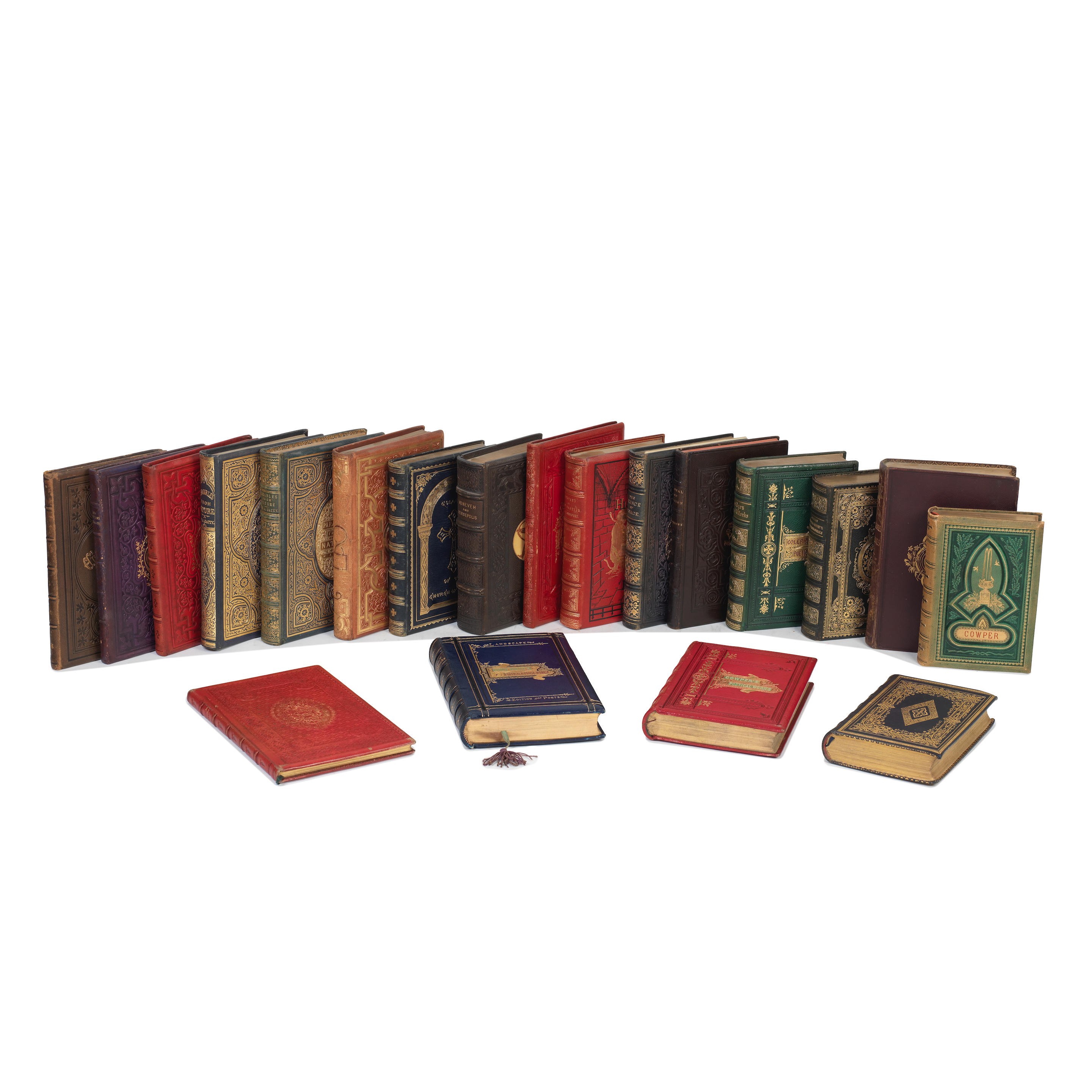John Henry Foley RA RHA (1818-1874)
Medium: electroplated bronze
Size: 20¼ x 9 x 4¾in. (51.44 x 22.86 x 12.07cm)
Size: 20¼ x 9 x 4¾in. (51.44 x 22.86 x 12.07cm) Provenance: Private collection, USA; Whyte's, 26 November 2007, lot 108; Private collection Exhibited: RHA, Dublin, 1861, catalogue no. 599; RA, London, 1861, catalogue no. 981 In July 1863, a large crowd gathered outside the front gates of Trinity College Dublin to watch as the Earl of Carlisle, the Lord Lieutenant of Ireland, pulled a green drape off a hidden entity and revealed an exquisitely chiselled 7ft 6-inch high st...Read more In July 1863, a large crowd gathered outside the front gates of Trinity College Dublin to watch as the Earl of Carlisle, the Lord Lieutenant of Ireland, pulled a green drape off a hidden entity and revealed an exquisitely chiselled 7ft 6-inch high statue of the poet, dramatist and essayist Oliver Goldsmith. It was Lord Carlisle who first proposed the idea of a Goldsmith statue and it was also his idea that it should stand outside of Trinity, where Goldsmith 'studied' in the 1740s. Goldsmith was no model student; he learned how to drink, dress smart, sing Irish airs, play cards and master the flute, shortly before he was suspended for participating in a riot in London in 1747. John Henry Foley (1818-74), the sculptor of the work, ignored such trivia, depicting a pensive, dignified Goldsmith holding an open book, a pencil to hand, with a fine neckerchief. Foley, who was born across the Liffey on what is now known as Foley Street in his honour, had been familiar with Goldsmith's works since childhood when 'The Vicar of Wakefield' had been his favourite book. A child prodigy, he mastered his craft under the brilliant Edward Smyth at the Royal Society Schools in Dublin. He arrived in London aged 18 on the eve of Queen Victoria's reign and gradually rose through the ranks to become one of the most celebrated members of the Royal Academy. There are more statues by Foley in Ireland than by any other sculptor, including the Daniel O'Connell monument on O'Connell Street and the statues of Edmund Burke and Henry Grattan that stand near Goldsmith on College Green. The Goldsmith maquette on sale here is almost certainly the original bronze statuette that Foley first presented in 1860.1 It bears neither the stamp of the foundry where it was made, nor Foley's name, which marks it as an earlier cast to the Elkington and Co. bronzes. This one-off piece was created to win the approval of the committee behind the Goldsmith Statue. This had been obtained by the time the statuette made its public debut at the Mansion House in London in November 1860. Shortly afterwards it crossed to Dublin where it went on show at the Royal Irish Academy. 2 In January 1861, 'in consequence of the universal admiration' it received, 'that eminent sculptor [was] directed to commence the execution of the large statute.' 3 He duly set to work at his London studio on Osnaburgh Street, off Regent's Park. The finished version had some subtle differences to the statuette, including a darker patina; some consider this diminutive prototype to be the fairer of the two. The latter was put on show at Thomas Cranfield's Grafton Street gallery, and also went on show at the Royal Hibernian Academy of Arts, as well as an exhibition hosted by the RDS. 4 It was also shown at the International Exhibition in 1862. 5 Turtle Bunbury January 2019 ABOUT JOHN HENRY FOLEY John Henry Foley (1818-1874) was probably the most influential sculptor in Irish history. Born in Dublin, his breath-taking statues and equestrian masterpieces strode across city squares and parklands from Dublin to Kolkata to Virginia. His best-known Irish works include the Daniel O'Connell monument on O'Connell Street and the Father Mathew statue in Cork. Queen Victoria personally requested Foley create the statue of her beloved husband for the Albert Memorial in London. When Foley died, the queen decreed that the gifted Irishman be buried in Westminster Abbey, an extraordinary honour for a man born into relative poverty in Dublin's northside.
John Henry Foley RA RHA (1818-1874)
Medium: electroplated bronze
Size: 20¼ x 9 x 4¾in. (51.44 x 22.86 x 12.07cm)
Size: 20¼ x 9 x 4¾in. (51.44 x 22.86 x 12.07cm) Provenance: Private collection, USA; Whyte's, 26 November 2007, lot 108; Private collection Exhibited: RHA, Dublin, 1861, catalogue no. 599; RA, London, 1861, catalogue no. 981 In July 1863, a large crowd gathered outside the front gates of Trinity College Dublin to watch as the Earl of Carlisle, the Lord Lieutenant of Ireland, pulled a green drape off a hidden entity and revealed an exquisitely chiselled 7ft 6-inch high st...Read more In July 1863, a large crowd gathered outside the front gates of Trinity College Dublin to watch as the Earl of Carlisle, the Lord Lieutenant of Ireland, pulled a green drape off a hidden entity and revealed an exquisitely chiselled 7ft 6-inch high statue of the poet, dramatist and essayist Oliver Goldsmith. It was Lord Carlisle who first proposed the idea of a Goldsmith statue and it was also his idea that it should stand outside of Trinity, where Goldsmith 'studied' in the 1740s. Goldsmith was no model student; he learned how to drink, dress smart, sing Irish airs, play cards and master the flute, shortly before he was suspended for participating in a riot in London in 1747. John Henry Foley (1818-74), the sculptor of the work, ignored such trivia, depicting a pensive, dignified Goldsmith holding an open book, a pencil to hand, with a fine neckerchief. Foley, who was born across the Liffey on what is now known as Foley Street in his honour, had been familiar with Goldsmith's works since childhood when 'The Vicar of Wakefield' had been his favourite book. A child prodigy, he mastered his craft under the brilliant Edward Smyth at the Royal Society Schools in Dublin. He arrived in London aged 18 on the eve of Queen Victoria's reign and gradually rose through the ranks to become one of the most celebrated members of the Royal Academy. There are more statues by Foley in Ireland than by any other sculptor, including the Daniel O'Connell monument on O'Connell Street and the statues of Edmund Burke and Henry Grattan that stand near Goldsmith on College Green. The Goldsmith maquette on sale here is almost certainly the original bronze statuette that Foley first presented in 1860.1 It bears neither the stamp of the foundry where it was made, nor Foley's name, which marks it as an earlier cast to the Elkington and Co. bronzes. This one-off piece was created to win the approval of the committee behind the Goldsmith Statue. This had been obtained by the time the statuette made its public debut at the Mansion House in London in November 1860. Shortly afterwards it crossed to Dublin where it went on show at the Royal Irish Academy. 2 In January 1861, 'in consequence of the universal admiration' it received, 'that eminent sculptor [was] directed to commence the execution of the large statute.' 3 He duly set to work at his London studio on Osnaburgh Street, off Regent's Park. The finished version had some subtle differences to the statuette, including a darker patina; some consider this diminutive prototype to be the fairer of the two. The latter was put on show at Thomas Cranfield's Grafton Street gallery, and also went on show at the Royal Hibernian Academy of Arts, as well as an exhibition hosted by the RDS. 4 It was also shown at the International Exhibition in 1862. 5 Turtle Bunbury January 2019 ABOUT JOHN HENRY FOLEY John Henry Foley (1818-1874) was probably the most influential sculptor in Irish history. Born in Dublin, his breath-taking statues and equestrian masterpieces strode across city squares and parklands from Dublin to Kolkata to Virginia. His best-known Irish works include the Daniel O'Connell monument on O'Connell Street and the Father Mathew statue in Cork. Queen Victoria personally requested Foley create the statue of her beloved husband for the Albert Memorial in London. When Foley died, the queen decreed that the gifted Irishman be buried in Westminster Abbey, an extraordinary honour for a man born into relative poverty in Dublin's northside.











Testen Sie LotSearch und seine Premium-Features 7 Tage - ohne Kosten!
Lassen Sie sich automatisch über neue Objekte in kommenden Auktionen benachrichtigen.
Suchauftrag anlegen